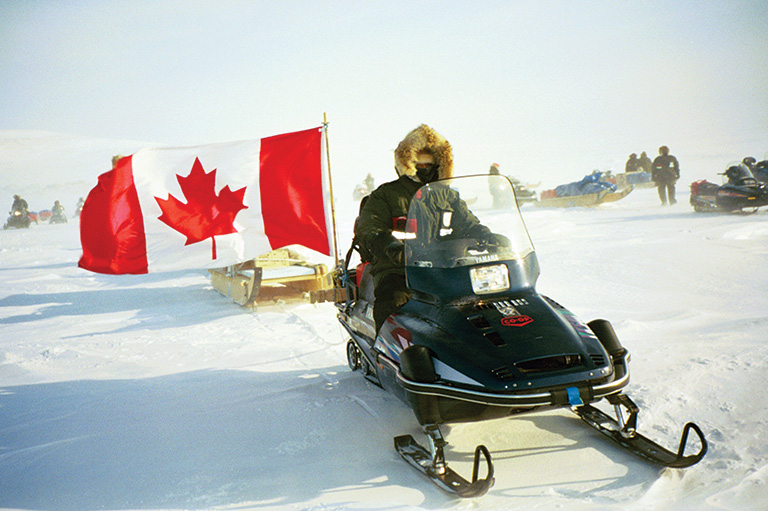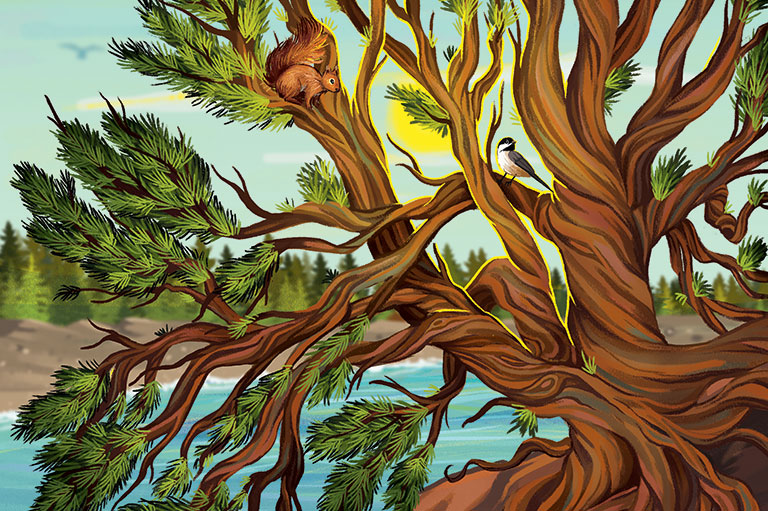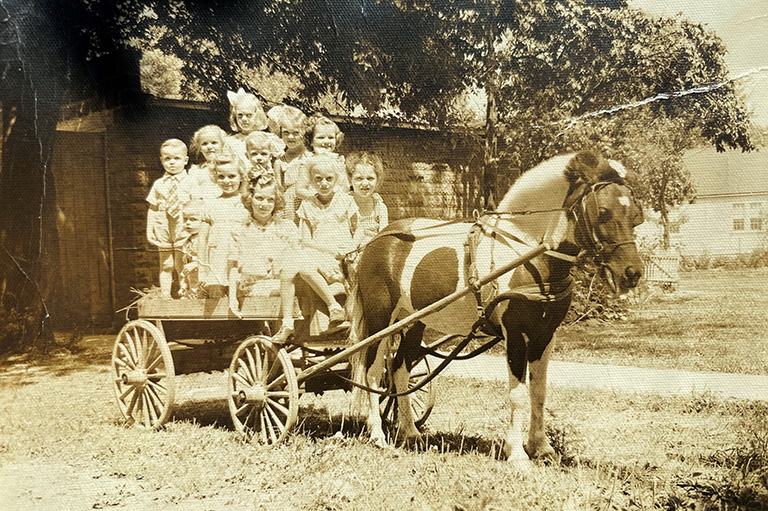Growing Their Own
-
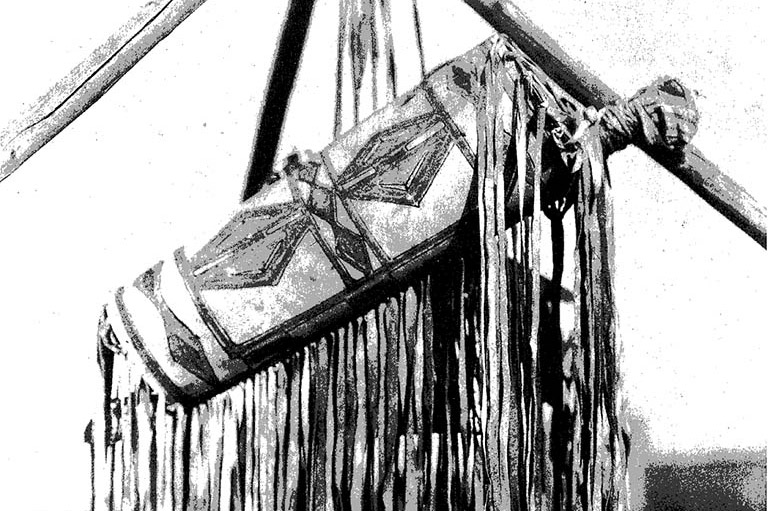 A Blackfoot ceremonial bundle, 1926. The religious life of the Blackfoot centred upon medicine bundles and their associated rituals. These bundles often originated from an encounter with a supernatural spirit.Glenbow Archives / NA-1700-17
A Blackfoot ceremonial bundle, 1926. The religious life of the Blackfoot centred upon medicine bundles and their associated rituals. These bundles often originated from an encounter with a supernatural spirit.Glenbow Archives / NA-1700-17 -
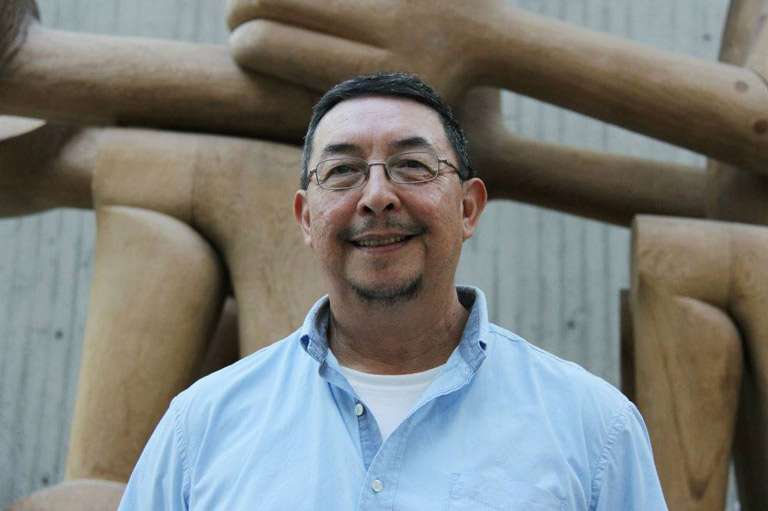 Eldon Yellowhorn is Blackfoot born and raised in the tiny town of Brocket on the Peigan reserve of southwestern Alberta. He grew up learning traditional lore from elders as well as what archaeologists were discovering about his heritage.
Eldon Yellowhorn is Blackfoot born and raised in the tiny town of Brocket on the Peigan reserve of southwestern Alberta. He grew up learning traditional lore from elders as well as what archaeologists were discovering about his heritage. -
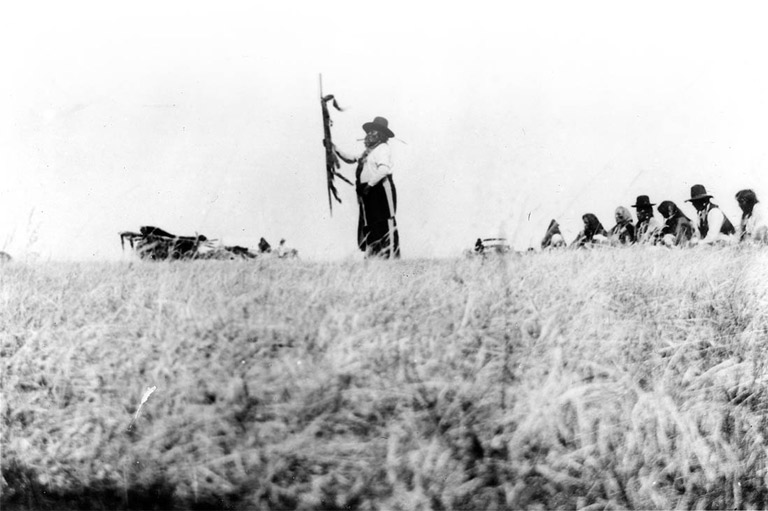 Blackfoot tobacco ceremonies in southern Alberta, circa 1910. Like other Plains cultures, the Blackfoot had age-graded men’s societies, each with its own distinctive songs, dances, and regalia.Glembow Archives / NA-809-1
Blackfoot tobacco ceremonies in southern Alberta, circa 1910. Like other Plains cultures, the Blackfoot had age-graded men’s societies, each with its own distinctive songs, dances, and regalia.Glembow Archives / NA-809-1 -
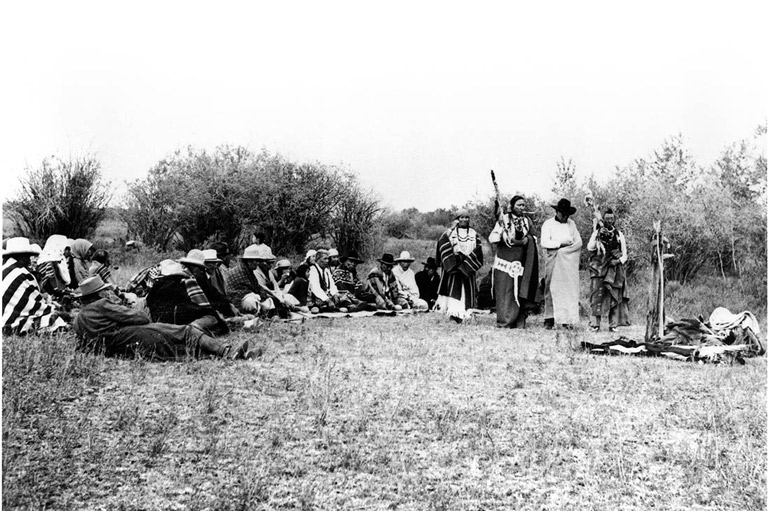 The tobacco society had exclusive responsibility for the cultivation of tobacco, which had both medicinal and ceremonial value. It served as a stimulant, a hunger and thirst depressant, and an analgesic.Glenbow Archives / NA-731-2
The tobacco society had exclusive responsibility for the cultivation of tobacco, which had both medicinal and ceremonial value. It served as a stimulant, a hunger and thirst depressant, and an analgesic.Glenbow Archives / NA-731-2 -
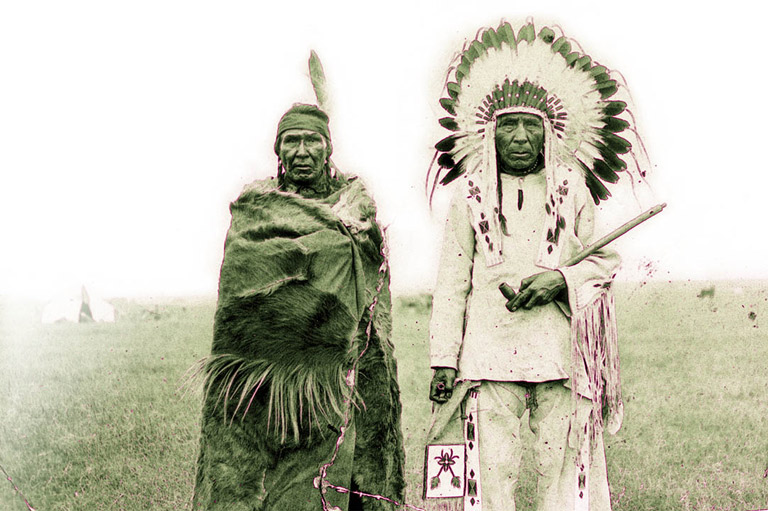 Two Blackfoot, Sun Calf (left, with tobacco pipe) and Jack Sun Calf, circa 1920.Glenbow Archives / NA-603-3
Two Blackfoot, Sun Calf (left, with tobacco pipe) and Jack Sun Calf, circa 1920.Glenbow Archives / NA-603-3
One crisp October morning in 1754, Anthony Henday encountered a few Blackfoot scouts in the hills near present-day Lethbridge, Alberta. He sat under the autumn yellows and reds and smoked with them. When he visited their camp two weeks later to discuss trade, again protocol had it that he first sit and smoke, this time with the elders.
Henday offered his favourite tobacco, but the Blackfoot leaders preferred their own. “They think nothing of my tobacco,” he later wrote in his journal. The feeling was mutual: he “set as little value on theirs, which is dryed Horse-dung.”
Eighteen years later, Matthew Cocking, another trade envoy, was riding in the same hills when one of his Cree guides discovered a plot of tobacco. He wrote of it, “The Natives shew me a tobacco plantation belonging to the [Blackfoot] about 100 yards long & 5 wide, sheltered from the northern blasts by a Ledge of poplars & to the Southward by a ridge of high ground.”
“In penning those lines, Cocking became the first person to record tobacco cultivation as practised by the Blackfoot.”
Which was fortunate because a few generations later, by around 1800, the Blackfoot had abandoned their tobacco gardens and adopted their intruders’ European blends.
But smoking had long been part of Blackfoot ritual and spiritualism, and the Blackfoot had evolved the specialized knowledge needed to grow successful crops of a species in a land too harsh for it to grow naturally. The knowledge was passed on through oral traditions. Critical in this process were tobacco societies, which were typically composed of elders who were adept at the complex rituals associated with tobacco cultivation.
“The tobacco societies were in effect a horticultural society,” says Eldon Yellowhorn, assistant professor of archaeology at Simon Fraser University and himself a Blackfoot. “Like people have for roses or orchids. They preserved the ecological information needed to produce successful crops of tobacco.”
Although tobacco now has a negative stigma, Yellowhorn says that “in traditional Blackfoot society it was rather esteemed.” Smoking of other herbs already had a ritual purpose before tobacco appeared on the northern plains around 1200 A.D., so the Blackfoot had the cultural background for accepting the product.
“It was a habit on the northern plains for at least 3,500 years,” he says, citing a dated find of a stone pipe at the Cactus Flower Site in southern Alberta by archaeologist John Brumley in 1973. “Blackfoot smoking pleasure was probably derived from a blend of bearberry [later known as kinnikinnick] and the cambium [inner bark] of red-osier dogwood, in a stone pipe.”
Accepting the practice of planting tobacco into their cultural system gave them access to a new herb that likely improved the flavour of these smoking blends, he says.
Smoking was primarily ceremonial, but “I imagine people would have their own times when they’re not doing anything and just relax and have a bowlful of whatever they’re smoking,” says Yellowhorn. “But ritual use of smoke represents a spirit, like the creation myth where it’s like Napi’s [the Blackfoot mythical creator] breath — you actually see it. These are the connections with smoking. It’s a physical manifestation of the spirit.”
Though the Blackfoot tobacco societies used myth and ceremonies to help make sense of the investment of labour by surrounding the practice with a spiritual purpose, the spiritual connection wasn’t tobacco’s only focus. The societies likely dispensed it for medicinal purposes, too.
“Medicines came out of its roots, the flowers, and you could brew the leaves to make an infusion to put on your sores,” says Yellowhorn. “It was likely even smoked medicinally because it deadens the nerves.”
The primacy of tobacco in Blackfoot society engendered intense ritual and ceremonialism associated with every step of its planting, protection, and harvest. The exact methods of cultivating the tobacco were closely guarded by the societies to ensure success. They also regulated trade because tobacco was a chief element in medicine bundles, which contained numerous items of spiritual significance.
Bundles, still a cornerstone of Blackfoot spirituality, were described by Clark Wissler in the 1911 Anthropological Papers of the American Museum of Natural History, “The Social Life of the Blackfoot Indians.”
Wissler wrote that there are many different types of bundles, most of which contained tobacco. They were opened only for the most compelling reasons, such as calling the buffalo, performing the sun dance, or planting tobacco. The beaver bundle was most important to the tobacco societies: it contains every sacred object essential to the tobacco-planting rituals.
According to Wissler, beaver bundles are filled with scores of items like beaver skins, a pipe, tobacco seeds and pouches of tobacco, buffalo ribs, tails and hooves, digging sticks, and muskrat and multitudes of other animal and bird skins. Accessories include sweetgrass and parsnip root for the smudge, black and red paints, rattles, rawhide, and counting sticks for keeping tally of the months.
The whole package is wrapped in tanned elkskin and kept at the rear of the tipi resting on a parfleche filled with dried meat and a bag of dried berries. The owner’s wife takes care of the bundle.
Planting tobacco involved ritual songs associated with the animal skins[1]. Dances, smudges, and painted faces accompany the ceremony. There were about four hundred songs in all, accompanied only by rattles beaten on leather.
Words in the tobacco songs include: “Tobacco seed, I want it. It is powerful... Tobacco seed, I want it. A plenty I have taken. It is powerful. ... Tobacco leaves, I have taken. It is powerful. Old Man, he says, ‘The plants, let us go over there’ [referring to the tobacco garden] ...”
And so the tobacco-planting ritual began. No account of a westerner observing one is on record, but Wissler recorded from a number of Blackfoot informants:
The holders of the beaver bundles, or “beaver men,” hold a four-day dancing and feast and send out “eight single young men to gather deer, antelope and mountain sheep dung, because these animals run fast and so the tobacco will grow fast.” The dung is mashed up with berries and tobacco leaves into which the seeds are placed with water[2]. The mixture is distributed among the planters who are both men and women. Brush is gathered and burned on the plot. Sometimes willow branches were used to mix the ash with the soil[3].
After the burning, with digging sticks or bison scapula hoes, “holes are dug about a foot apart and two inches deep in a row, into which are placed the seeds and covered by children running over them four times,” recorded Wissler[4]. “A child cannot fall or ... ill luck will follow.”
After the planting, special songs are sung and four smudges lit, one on each corner of the plot. Camp is then broken in preparation for a spring departure of the entire group for a summer away hunting and gathering.
While they’re away, they must camp in four different places of increasing distances from the garden while mythical “little people” tend to the crop. “Some say the seeds are the dwarf people,” wrote Wissler. “No one must ever try to see the little people for if you do you will die.”[5]
At the fourth campsite, the women make tiny moccasins about five centimetres long and bags of food about seven centimetres long and put them out for the little people. The group then spends the rest of the summer hunting and gathering.
No archaeological evidence has been found of Blackfoot tobacco gardens. But carbonized seeds have been recovered at many sites along the Missouri River, including the Travis site in north central South Dakota, that were first cultivated about a thousand years ago.
Indeed, the origin of the Blackfoot tobacco societies’ ceremonies and methods of cultivation are thought to have derived from the Crow Indians of the Missouri area. “The Crow Indians have a long tradition of growing tobacco,” says Yellowhorn. “The Blackfoot adopted some of their rituals and knowledge and plant lore to cultivate tobacco into their societies.”
Descriptions of Crow ceremonial planting of the tobacco were recorded by anthropologist Robert Lowie and published in Anthropological Papers of the American Museum of Natural History in 1919.
He notes that, unlike the Blackfoot, the Crow at that time still planted their own tobacco for ceremonial purposes. Lowie recorded that although the Crow rituals differed slightly, the Blackfoot and the Sarcee were the only other tribes with ceremonial tobacco planting.
Perhaps some of the differences arose from a factor the Crow of the Missouri didn’t have to worry about: Blackfoot territory lay at the extreme northern edge of the plant’s growing range with the ever-present danger of killing frosts. And here’s where they got help from the beaver, says Yellowhorn.
As well as the mythical bringing of the original tobacco seed, the beaver and its aquatic habits played a leading role in ensuring the success of the crop by imparting information crucial for timing and locating tobacco.
“...the beaver and its aquatic habits played a leading role in ensuring the success of the crop by imparting information crucial for timing and locating tobacco.”
Beaver habitat on the plains is restricted to forested valleys where the high water tables can support lush and woody vegetation such as aspen and poplar. This is also where tobacco gardens produce best, and it obviates any need to stick around for irrigation.
Beaver prefer backwater channels that flood periodically, forming deposits of well-drained sandy loams suited to tobacco plants. And a local microclimate is created by a canopy of sheltering trees adjacent to the riverbanks, which protects young shoots against sudden late spring frosts or blizzards.
The water releases its latent heat under the cooler temperatures to insulate the new plants. “So the ecology of the beaver was a perfect match for the ecology of the tobacco,” says Yellowhorn.
To help pull it all off, some kind of reliable calendar was needed. Wissler recorded sets of sticks being used to keep tally of the days for planting. “They claim twenty-six days for a moon and four days for which the moon is invisible, making a period of thirty days,” he wrote.
Yellowhorn says that would have been very close to the modern measurement of 29.53 days for a lunar month. Counting the seven moons of winter began when the leaves turned yellow. Seven moons of 29.53 days comfortably passes the vernal equinox, so the final new moon of winter would be around the middle of April, and that’s when plans would begin for the planting ceremonies.
According to Wissler’s observations, when the band returned in the fall, four young men were first sent ahead — one to each corner of the plot to pull up a tobacco vine. These they took back to the beaver men (of the tobacco society) at the approaching camp for inspection. Satisfied, the band would head back to camp for a four-day feast. The beaver men would then harvest, dry, and cut the tobacco for winter storage.
Today, many of the planting and harvesting rituals are still performed and held sacred by the tobacco societies, though they no longer serve any practical purpose. Bundles contain tobacco in tubes or containers; it’s never loose. And still, meetings with Blackfoot people traditionally open with tobacco. When medicine pipe and beaver bundle owners open their bundles at the first sound of spring thunder, people at the opening are given tobacco.
“Distributing tobacco to those in attendance is an essential communion between host and guests,” says Yellowhorn. Regardless of how it tastes, Anthony Henday and Matthew Cocking would surely agree.
Footnotes
1. Eldon Yellowhorn explains: “The different animals each contributed a song, and each skin in the bundle is the memory aid for that song. Many of the skins of birds are of those that migrate onto the northern plains in the springtime. Spring is very important in the bundle opening. My feeling is there is a correlation between the types of animals that hibernate and become active after winter.”
2. In a practical sense, of course, the dung wouldn’t have to come specifically from deer, antelope, or mountain sheep-it served merely as a fertilizer for the tobacco crop.
3. Yellowhorn explains this step: “The seed case around the tobacco seed has to be leached off. The ash dissolved the case off the tobacco seed.
4. This ritual may have had its origins in the need to lightly tamp the soil after planting.
5. This belief may have originated to dissuade anyone from raiding the garden.
Themes associated with this article
Advertisement

